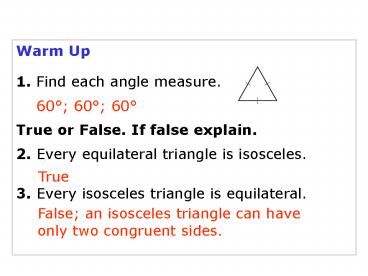Isosceles Triangles - PowerPoint PPT Presentation
1 / 17
Title:
Isosceles Triangles
Description:
Every isosceles triangle is equilateral. 60 ; 60 ; 60 True ... Apply properties of isosceles triangles. Recall that an isosceles triangle has at least two ... – PowerPoint PPT presentation
Number of Views:805
Avg rating:3.0/5.0
Title: Isosceles Triangles
1
- Warm Up
- 1. Find each angle measure.
- True or False. If false explain.
- 2. Every equilateral triangle is isosceles.
- 3. Every isosceles triangle is equilateral.
60 60 60
True
False an isosceles triangle can have only two
congruent sides.
2
Isosceles Triangles
- 4.2
- Apply properties of isosceles triangles.
3
Recall that an isosceles triangle has at least
two congruent sides. The congruent sides are
called the legs. The vertex angle is the angle
formed by the legs. The side opposite the vertex
angle is called the base, and the base angles are
the two angles that have the base as a side.
?3 is the vertex angle. ?1 and ?2 are the base
angles.
4
4-1
4-3
5
Theorem 4-2
- The bisector of the vertex of an isosceles
triangle is the perpendicular bisector of the
base
6
Example 1 Astronomy Application
The m?YZX 180 140, so m?YZX 40.
Since ?YZX ? ?X, ?XYZ is isosceles by the
Converse of the Isosceles Triangle Theorem.
Thus YZ YX 20 ft.
7
Example 2 Finding the Measure of an Angle
Find m?F.
m?F m?D x
Isosc. ? Thm.
m?F m?D m?A 180
? Sum Thm.
Substitute the given values.
x x 22 180
Simplify and subtract 22 from both sides.
2x 158
Divide both sides by 2.
x 79?
Thus m?F 79
8
Example 3 Finding the Measure of an Angle
Find m?G.
m?J m?G
Isosc. ? Thm.
Substitute the given values.
(x 44)? 3x?
Simplify x from both sides.
44 2x
Divide both sides by 2.
x 22?
Thus m?G 22 44 66.
9
Check It Out! Example 4
Find m?H.
m?H m?G x
Isosc. ? Thm.
m?H m?G m?F 180
? Sum Thm.
Substitute the given values.
x x 48 180
Simplify and subtract 48 from both sides.
2x 132
Divide both sides by 2.
x 66?
Thus m?H 66
10
Check It Out! Example 5
Find m?N.
m?P m?N
Isosc. ? Thm.
Substitute the given values.
(8y 16)? 6y?
Subtract 6y and add 16 to both sides.
2y 16
Divide both sides by 2.
y 8?
Thus m?N 6(8) 48.
11
The following corollary and its converse show the
connection between equilateral triangles and
equiangular triangles.
12
(No Transcript)
13
Example 6 Using Properties of Equilateral
Triangles
Find the value of x.
?LKM is equilateral.
Equilateral ? ? equiangular ?
The measure of each ? of an equiangular ? is 60.
(2x 32)? 60?
Subtract 32 both sides.
2x 28
Divide both sides by 2.
x 14
14
Example 7 Using Properties of Equilateral
Triangles
Find the value of y.
?NPO is equiangular.
Equiangular ? ? equilateral ?
Definition of equilateral ?.
5y 6 4y 12
Subtract 4y and add 6 to both sides.
y 18
15
Check It Out! Example 8
Find the value of JL.
?JKL is equiangular.
Equiangular ? ? equilateral ?
Definition of equilateral ?.
4t 8 2t 1
Subtract 4y and add 6 to both sides.
2t 9
t 4.5
Divide both sides by 2.
Thus JL 2(4.5) 1 10.
16
Lesson Quiz Part I
Find each angle measure. 1. m?R 2. m?P Find
each value. 3. x 4. y 5. x
28
124
6
20
26
17
Homework
- Pg. 191 1-8, 12-15, 18, 26-33































